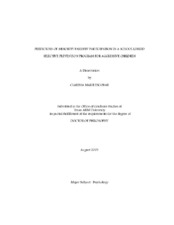| dc.description.abstract | The present study examines the issue of minority participation in a multi-faceted prevention program for youth with problem behavior. Historically, participation in such research programs has been low (Myers, Alvy, Richardson, Arrington, Marigna, Huff, Main, & Newcomb, 1990; Coie, 1996; Spoth & Redmond, 2001). Targeted prevention programs, which design their interventions for populations that are susceptible to negative outcomes, face more obstacles to participation than most participants of universal prevention programs. Targeted populations, specifically families with children with problem behavior, are usually under great duress, suffer multiple hardships, and have high adversity characteristics, (e.g., low socioeconomic status, insularity, single-parent families, and low levels of education). As has long been documented, minority status is usually associated with this heightened risk status (Prinz & Miller, 1991). A common suggestion in the prevention and therapeutic treatment literature is the use of minority staff members to increase the likelihood of participation of minority parents (Prinz, Smith, Dumas, Laughlin, White & Barron, 2001). This argument is most prevalent in the literature regarding Latino clients (Sue, Fujino, Hu, Takeuchi, & Zane, 1991). This study attempts to predict minority parents' participation quality (PQ) from demographic variables (e.g., level of adversity, ethnicity), participation rate (PR) (e.g., amount of participation measured by minutes and contacts), and ethnic matching. This study also offers insight on how PQ and PR relate to one another. The results of this study imply that PQ and PR relate differently for Latino parents than they do for parents from other ethnicities. The relationship of these variables has implications for frequency of dosages in an intervention, especially for interventions that attempt to reach distinct populations. | en |


